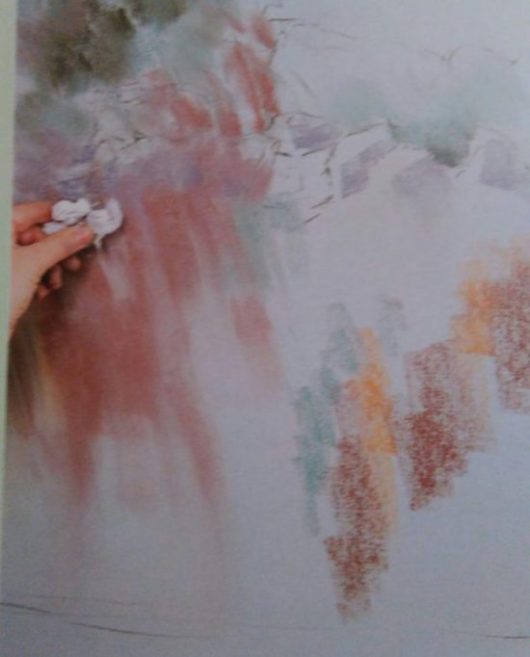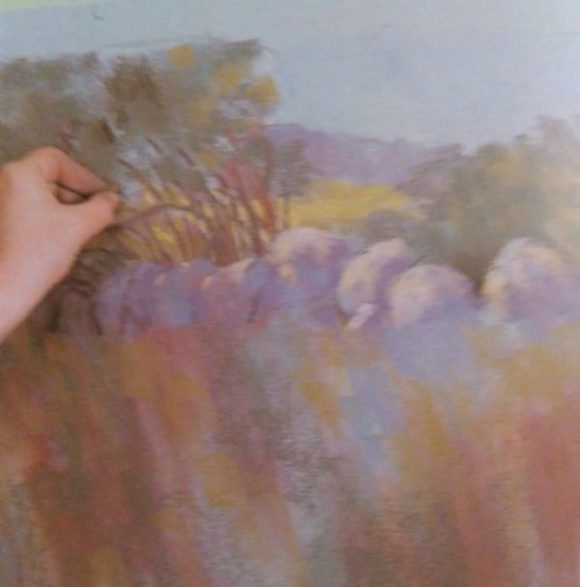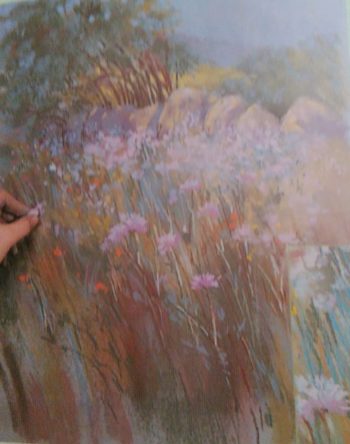Expression “scattered paint” goes for drawings built with short moves adding layers of pure pigments which are not connected but allow the paper to be seen underneath. Observed from a certain distance those moves look like they are blending into the coloured mass but the effect is different than one gained by covering the surface by blending colours.
What happens is that those small dots of colour “twinkle” on the retina giving the impression that they are shining creating a lighter expression then uniform coloured surface. If there are complementary colours placed next to
This impression can be further amplified by using the coloured paper which will ad harmony to the drawing. This technique is used both in painting and in drawing and is usually tied to French impressionists which were the first to explore all of its possibilities at the end of the 19th century.
Impressionists where fascinated by changeable effects of light in landscapes and they realized that using a small colour spreads and smears they can capture that effect on surfaces like water or shade underneath trees and multiple layers of colour made paintings look like they were twinkling with light.



How is it done
Pastels and coloured pencils are especially suitable for this technique because of pure pigments and the fact they are easy to handle and work with. I would recommend you to stick to a very limited pallet tho, in order to maintain coherency. Also, you should use colours that are similar in tone or your drawings will lose the shimmering effect of light.
The goal of this technique is to achieve the effect of proximity. Colours should be added quickly and confidently and left as they are without trying to blend them. Always try changing size, shape and thickness of your strokes or else the drawing will appear monotonous. By changing the pressure added while drawing you can get a scale of dots, lines and scattered smears that give your drawing sense of life and movement.
Field with flowers
This drawing was done at the scene. In order to express the richness of textures and colours on the field, the artist used blending together with colour scattering.
For this drawing, you will need the following:
- A sheet of bluish grey pastel paper
- A thin charcoal stick
- Spray fixative
and soft pastels in the following colours:
- Reddish brown
- Ochre
- Blue-green
- Light cobalt blue
- Blue
- MIddle olive
- Green
- Lemon yellow
- Bluegrey
- Light cream
- Golden yellow
- Middle brown
- Dark brown
- Purple
- Turquoise blue
- Light blue
- Red grey
- Light blue
- Orange-red
- Light pink
- Purple pink
- LIght purple blue
- Yellow-green


Working on the smoother side of the paper mark the position of the wall and scenery behind it using the charcoal stick. The blue-grey paper gives you a nice middle tone for achieving darker and lighter areas on your drawing.
Roughly sketch main coloured surfaces with wide moves. Use blue-green for trees in the distance, and then start working on the front plane with the reddish brown and ochre. Add layers of grey and purple on the edges. Use a piece of cloth to blend the added layers. That way you will create a thin film on the surface you draw on which will help emphasize all the layers of colour added on it.
Cover the sky area with the lighter nuance of cobalt blue and draw the hills in the distance with purple-grey. Work on the front plane using cold blue-grey and warm olive green adding and blending colours to achieve a lively surface of different colours.
WIth long wide strokes draw high grass and using the same colours draw treetops.
Preserving the first layers
At this point of drawing, you need to use spray fixative to preserve colours from smearing. Spray a small amount of fixative on your drawing to be able to continue adding additional layers of colour to it. Always remember to spray fixative from the distance so you do not damage the drawing. Add lemon yellow with short strokes on the field in the background.
Draw shades on the border wall with short strokes of purple, bluish grey and cobalt blue. Catch the reflection of the sun rays on the border stones with soft yellow, pink and cream tones and then use the charcoal stick to draw the edges of individual stones. For trees use warm and cold brown and purple tones using the tip of the pastel stick.
On cold silver areas of the leaves, you will add a middle nuance of turquoise blue. Use the same colour for the front plane of the field that will help you to balance your drawing. Bring in lighter tones by adding pale cream and smearing it with your finger. Combination of smeared and lined areas of colour on the drawing gives it “winkling” effect.
To open up the treetops and create the impression you can see the sky through them add little areas of cobalt blue. Add golden yellow on the areas of the stones that are exposed to sunlight.


Adding the details
Start building linear details on top of blended traces in the front plane. With cream, light blue, pale bluish purple and reddish grey using the tip of the pastel stick add lively expressive lines drawing the field flowers. Long strokes of dark green, olive green red-brown and ochre will give depth and structure to the grass.
Draw light green and cream lines for lighter areas of the grass and continue working on the flowers using the same colours. Add a couple of bright yellow and orange-red flowers here and there, draw clear dots with pastels and rub them in the paper to create smears of lively saturated colour.
In order to give depth to your drawing use bigger thicker lines for flowers in the front plane and smaller softer smears for the ones in the back area of the drawing. To point out the central part of the drawing use pale pink and purple pink to draw the daises. Purple pink you should use to draw the lower part of the daisies and for the upper part of the petals use pale pink.


Finishing the drawing
To hills in the distance add some light blue to emphasize the feeling of distance. Work on the texture of the darker grass in the front plane with short lines, smears and dots using turquoise blue, blue-green and ochre to give it the sense of movement. Draw dots and circular lines to make an impression of intertwined grass.
Add smears of dark green colour between the flowers to point out their brightness. With yellow-green colour some areas on treetops to give an impression of sunrays. Use the same colour between the grass in the front plane to give balance to your drawing. At the end “illuminate” the rocks and flowers with pale cream.
Step away from your drawing, see if everything on it looks balanced, add details if you think you have to and when you are satisfied with it use spray fixative to protect the colours from smearing.
If you have any questions concerning this subject you can leave them below and I’ll be happy to answer them.





0 Comments